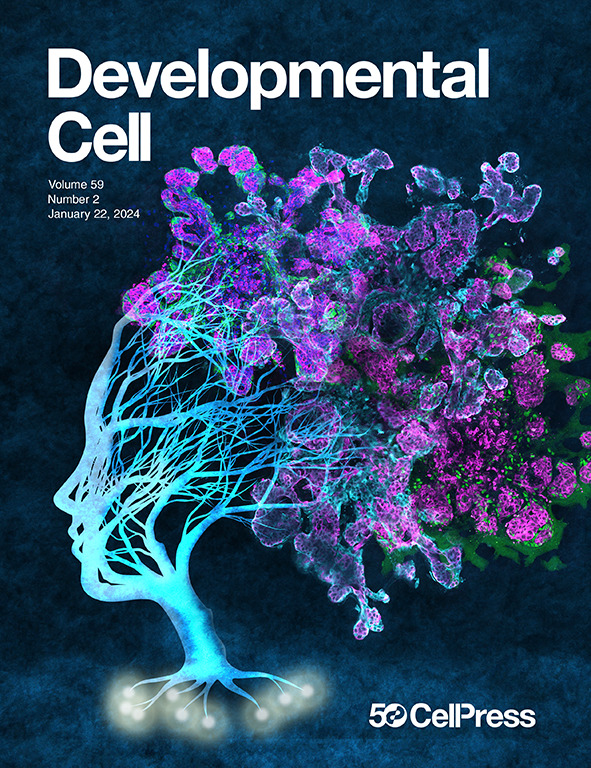基因组进化重塑了羊膜脑的细胞类型多样化
IF 8.7
1区 生物学
Q1 CELL BIOLOGY
引用次数: 0
摘要
经过3.2亿年的进化,羊膜动物通过大量未被探索的遗传和基因表达机制发展出复杂的大脑和认知能力。我们从海龟、斑胸草雀、鸽子、老鼠和猕猴的端脑和小脑中提取了超过130万个细胞,建立了一个全面的单细胞图谱,利用单细胞分辨率空间转录组学来验证物种间的基因表达模式。我们的研究确定了细胞类型的显著物种特异性变化,突出了它们在进化中的保护和多样化。我们发现鸟类和哺乳动物在端脑兴奋性神经元(EXs)和小脑细胞类型上存在显著差异。鸟类主要在EX中表达SLC17A6,而哺乳动物在新皮层和其他部位表达SLC17A7,这可能是由于鸟类SLC17A7功能缺失所致。此外,我们还发现了一种鸟类特有的浦肯野细胞亚型(SVIL+),它与学习和昼夜节律中的赖氨酸特异性去甲基酶11 (LSD1)/KDM1A通路有关,并且包含许多正选择基因,这表明小脑功能的进化优化是为了适应生态和行为。我们的研究结果阐明了遗传进化和环境适应之间复杂的相互作用,强调了遗传多样化在羊膜细胞特化类型发展中的作用。本文章由计算机程序翻译,如有差异,请以英文原文为准。

Genomic evolution reshapes cell-type diversification in the amniote brain
Over 320 million years of evolution, amniotes have developed complex brains and cognition through largely unexplored genetic and gene expression mechanisms. We created a comprehensive single-cell atlas of over 1.3 million cells from the telencephalon and cerebellum of turtles, zebra finches, pigeons, mice, and macaques, employing single-cell resolution spatial transcriptomics to validate gene expression patterns across species. Our study identifies significant species-specific variations in cell types, highlighting their conservation and diversification in evolution. We found pronounced differences in telencephalon excitatory neurons (EXs) and cerebellar cell types between birds and mammals. Birds predominantly express SLC17A6 in EX, whereas mammals express SLC17A7 in the neocortex and SLC17A6 elsewhere, possibly due to loss of function of SLC17A7 in birds. Additionally, we identified a bird-specific Purkinje cell subtype (SVIL+), implicating the lysine-specific demethylase 11 (LSD1)/KDM1A pathway in learning and circadian rhythms and containing numerous positively selected genes, which suggests an evolutionary optimization of cerebellar functions for ecological and behavioral adaptation. Our findings elucidate the complex interplay between genetic evolution and environmental adaptation, underscoring the role of genetic diversification in the development of specialized cell types across amniotes.
求助全文
通过发布文献求助,成功后即可免费获取论文全文。
去求助
来源期刊

Developmental cell
生物-发育生物学
CiteScore
18.90
自引率
1.70%
发文量
203
审稿时长
3-6 weeks
期刊介绍:
Developmental Cell, established in 2001, is a comprehensive journal that explores a wide range of topics in cell and developmental biology. Our publication encompasses work across various disciplines within biology, with a particular emphasis on investigating the intersections between cell biology, developmental biology, and other related fields. Our primary objective is to present research conducted through a cell biological perspective, addressing the essential mechanisms governing cell function, cellular interactions, and responses to the environment. Moreover, we focus on understanding the collective behavior of cells, culminating in the formation of tissues, organs, and whole organisms, while also investigating the consequences of any malfunctions in these intricate processes.
 求助内容:
求助内容: 应助结果提醒方式:
应助结果提醒方式:


